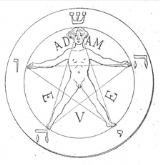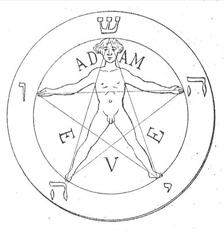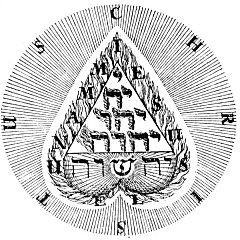
Yahshuah
Encyclopedia
Yahshuah is a form of the Hebrew
name of Jesus
produced by mystical speculation at various periods of history, but which is rejected by mainstream linguistics and textual scholarship in the field of ancient languages. The essential idea is of an alphabetic consonantal framework Y-H-Sh-W-H, which can be supplied with vowels in various ways. (Also, the "W" can be converted into a "U", since the Hebrew letter ו waw writes either a [w] consonant sound — later on pronounced [v] — or a long [u] vowel sound: see Mater Lectionis.)

 The first ones to use a name of Jesus something like "Yahshuah" were Renaissance occultists. In the second half of the 16th century, when knowledge of Biblical Hebrew first began to spread among a significant number of Christians, certain esoterically-minded or occultistic circles came up with the idea of deriving the Hebrew name of Jesus by adding the Hebrew letter shin ש into the middle of the Tetragrammaton
The first ones to use a name of Jesus something like "Yahshuah" were Renaissance occultists. In the second half of the 16th century, when knowledge of Biblical Hebrew first began to spread among a significant number of Christians, certain esoterically-minded or occultistic circles came up with the idea of deriving the Hebrew name of Jesus by adding the Hebrew letter shin ש into the middle of the Tetragrammaton
divine name yod-he-waw-he יהוה to produce the form yod-he-shin-waw-he יהשוה.
This was given a basic Latin
transliteration JHSVH or IHSVH or IHSUH (since there was no letter "W" or sh / [š] sound in Latin, and "I" and "J" were then not yet clearly distinguished as letters of the alphabet, nor were "U" and "V"). This could then be supplied with further vowels for pronounceability. It was a coincidence that the first three letters of this consonantal transcription IHSVH etc. were identical with the old IHS/JHS monogram of the name of Jesus
(from Greek iota-eta-sigma).
In Renaissance occultistic works, this Pentagrammaton (or five-letter divine name) was frequently arranged around a mystic pentagram, where each of the five Hebrew letters י ה ש ו ה was placed at one of the points (the letter shin ש was always placed at the upward-pointing vertex of the pentagram). One of the earliest attested examples of this diagram is in the Calendarium Naturale Magicum Perpetuum or "Magical Calendar" (published 1620 but dated 1582). This idea of the Pentagrammaton was funneled into modern occultism by 19th-century French writer Eliphas Levi
and the influential late 19th-century society of the Golden Dawn
. The Golden Dawn favored the consonantal transcription IHShVH or YHShVH, and the pronunciation Yeheshuah.
However, in all early Hebrew or Aramaic sources, the name "Jesus"/"Jeshua" actually appears as yod-shin-waw-`ayin ישוע Yeshua
(or as the related longer form of the same name, yod-he-waw-shin-`ayin יהושע "Joshua"; or as the intentionally-altered derogatory Talmudic variant yod-shin-waw ישו Yeshu
), so that the Renaissance speculations were incorrect. Note that the letter `ayin ע was specifically pronounced as a voiced pharyngeal consonant
sound in ancient Hebrew and Aramaic, and could not be easily confused with either a pronounced [h] sound or a silent Hebrew letter he ה.
.
When a final "H" is added on to these transcriptions (e.g. Yahshuah, Yahoshuah etc.), or when such consonantal transcriptions as YHSWH or YHShWH are used (both quite similar to the old transcription JHSVH, given the differences between the English and Latin uses of the alphabet), then it seems rather clear that there is confusion between the name of Jesus and the Tetragrammaton (whether under the influence of the old occultistic "Pentagrammaton", or independently). The consonantal transcription YHShVH is used both by occultists and Divine Name religious adherents.
Hebrew language
Hebrew is a Semitic language of the Afroasiatic language family. Culturally, is it considered by Jews and other religious groups as the language of the Jewish people, though other Jewish languages had originated among diaspora Jews, and the Hebrew language is also used by non-Jewish groups, such...
name of Jesus
Jesus
Jesus of Nazareth , commonly referred to as Jesus Christ or simply as Jesus or Christ, is the central figure of Christianity...
produced by mystical speculation at various periods of history, but which is rejected by mainstream linguistics and textual scholarship in the field of ancient languages. The essential idea is of an alphabetic consonantal framework Y-H-Sh-W-H, which can be supplied with vowels in various ways. (Also, the "W" can be converted into a "U", since the Hebrew letter ו waw writes either a [w] consonant sound — later on pronounced [v] — or a long [u] vowel sound: see Mater Lectionis.)
Renaissance occultism


Tetragrammaton
The term Tetragrammaton refers to the name of the God of Israel YHWH used in the Hebrew Bible.-Hebrew Bible:...
divine name yod-he-waw-he יהוה to produce the form yod-he-shin-waw-he יהשוה.
This was given a basic Latin
Latin
Latin is an Italic language originally spoken in Latium and Ancient Rome. It, along with most European languages, is a descendant of the ancient Proto-Indo-European language. Although it is considered a dead language, a number of scholars and members of the Christian clergy speak it fluently, and...
transliteration JHSVH or IHSVH or IHSUH (since there was no letter "W" or sh / [š] sound in Latin, and "I" and "J" were then not yet clearly distinguished as letters of the alphabet, nor were "U" and "V"). This could then be supplied with further vowels for pronounceability. It was a coincidence that the first three letters of this consonantal transcription IHSVH etc. were identical with the old IHS/JHS monogram of the name of Jesus
Christogram
A Christogram is a monogram or combination of letters that forms an abbreviation for the name of Jesus Christ, traditionally used as a Christian symbol. Different types of Christograms are associated with the various traditions of Christianity, e.g...
(from Greek iota-eta-sigma).
In Renaissance occultistic works, this Pentagrammaton (or five-letter divine name) was frequently arranged around a mystic pentagram, where each of the five Hebrew letters י ה ש ו ה was placed at one of the points (the letter shin ש was always placed at the upward-pointing vertex of the pentagram). One of the earliest attested examples of this diagram is in the Calendarium Naturale Magicum Perpetuum or "Magical Calendar" (published 1620 but dated 1582). This idea of the Pentagrammaton was funneled into modern occultism by 19th-century French writer Eliphas Levi
Eliphas Levi
Eliphas Lévi, born Alphonse Louis Constant , was a French occult author and purported magician."Eliphas Lévi," the name under which he published his books, was his attempt to translate or transliterate his given names "Alphonse Louis" into Hebrew although he was not Jewish.His second wife was...
and the influential late 19th-century society of the Golden Dawn
Hermetic Order of the Golden Dawn
The Hermetic Order of the Golden Dawn was a magical order active in Great Britain during the late 19th and early 20th centuries, which practiced theurgy and spiritual development...
. The Golden Dawn favored the consonantal transcription IHShVH or YHShVH, and the pronunciation Yeheshuah.
However, in all early Hebrew or Aramaic sources, the name "Jesus"/"Jeshua" actually appears as yod-shin-waw-`ayin ישוע Yeshua
Yeshua (name)
Yeshua, was a common alternative form of the name Joshua "Yehoshuah" in later books of the Hebrew Bible and among Jews of the Second Temple Period...
(or as the related longer form of the same name, yod-he-waw-shin-`ayin יהושע "Joshua"; or as the intentionally-altered derogatory Talmudic variant yod-shin-waw ישו Yeshu
Yeshu
Yeshu is the name of an individual or individuals mentioned in Rabbinic literature. The oldest works in which references to Yeshu occur are the Tosefta and the Talmud, although some scholars consider the references to Yeshu to be post-Talmudic additions....
), so that the Renaissance speculations were incorrect. Note that the letter `ayin ע was specifically pronounced as a voiced pharyngeal consonant
Pharyngeal consonant
A pharyngeal consonant is a type of consonant which is articulated with the root of the tongue against the pharynx.-Pharyngeal consonants in the IPA:Pharyngeal consonants in the International Phonetic Alphabet :...
sound in ancient Hebrew and Aramaic, and could not be easily confused with either a pronounced [h] sound or a silent Hebrew letter he ה.
Modern "Divine Name" groups
Some modern religious groups have speculated that the most correct form of the Hebrew name of Jesus should be based on the spelling yod-he-shin-waw-`ayin יהשוע (apparently a reordering of the letters in the Hebrew spelling of the name yod-he-waw-shin-`ayin יהושע, pronounced [yěhōšūǎ`] and usually translated into English as "Joshua", but closely connected with the Hebrew form of the name of Jesus). This Hebrew letter sequence yod-he-shin-waw-`ayin can be transcribed into English in various ways (since Masoretic Niqqud is rejected), including Yahshua, Yahoshua, etc. — see YahshuaYahshua
Yahshua is an argued transliteration of the original Hebrew or Aramaic name of Jesus commonly used by individuals in the Sacred Name Movement....
.
When a final "H" is added on to these transcriptions (e.g. Yahshuah, Yahoshuah etc.), or when such consonantal transcriptions as YHSWH or YHShWH are used (both quite similar to the old transcription JHSVH, given the differences between the English and Latin uses of the alphabet), then it seems rather clear that there is confusion between the name of Jesus and the Tetragrammaton (whether under the influence of the old occultistic "Pentagrammaton", or independently). The consonantal transcription YHShVH is used both by occultists and Divine Name religious adherents.
External links
- The correct form of the name of Jesus in several Semitic languages
- Jesus or Yahshuah?, argument for use of Hebrew name of Yahshuah

